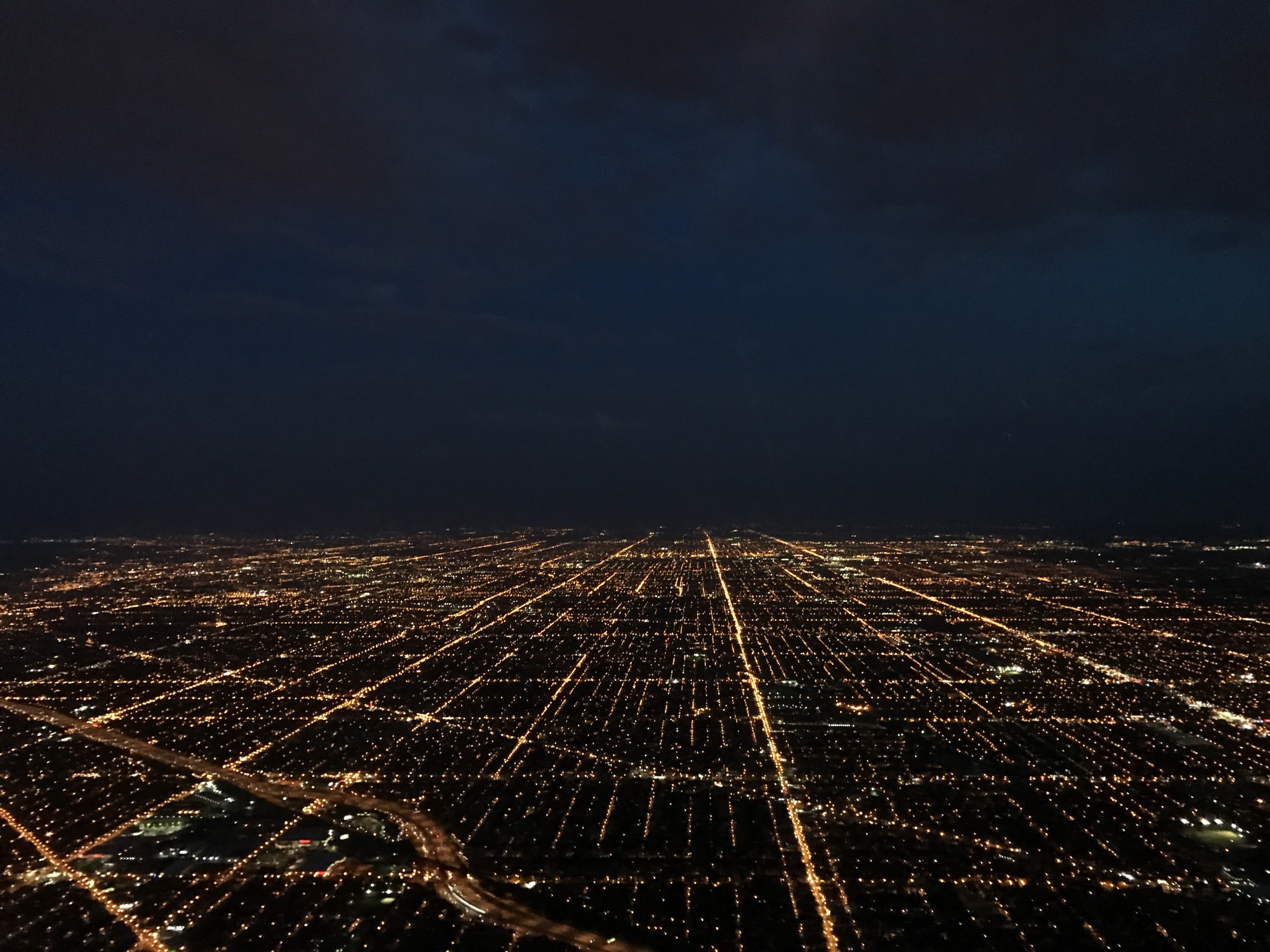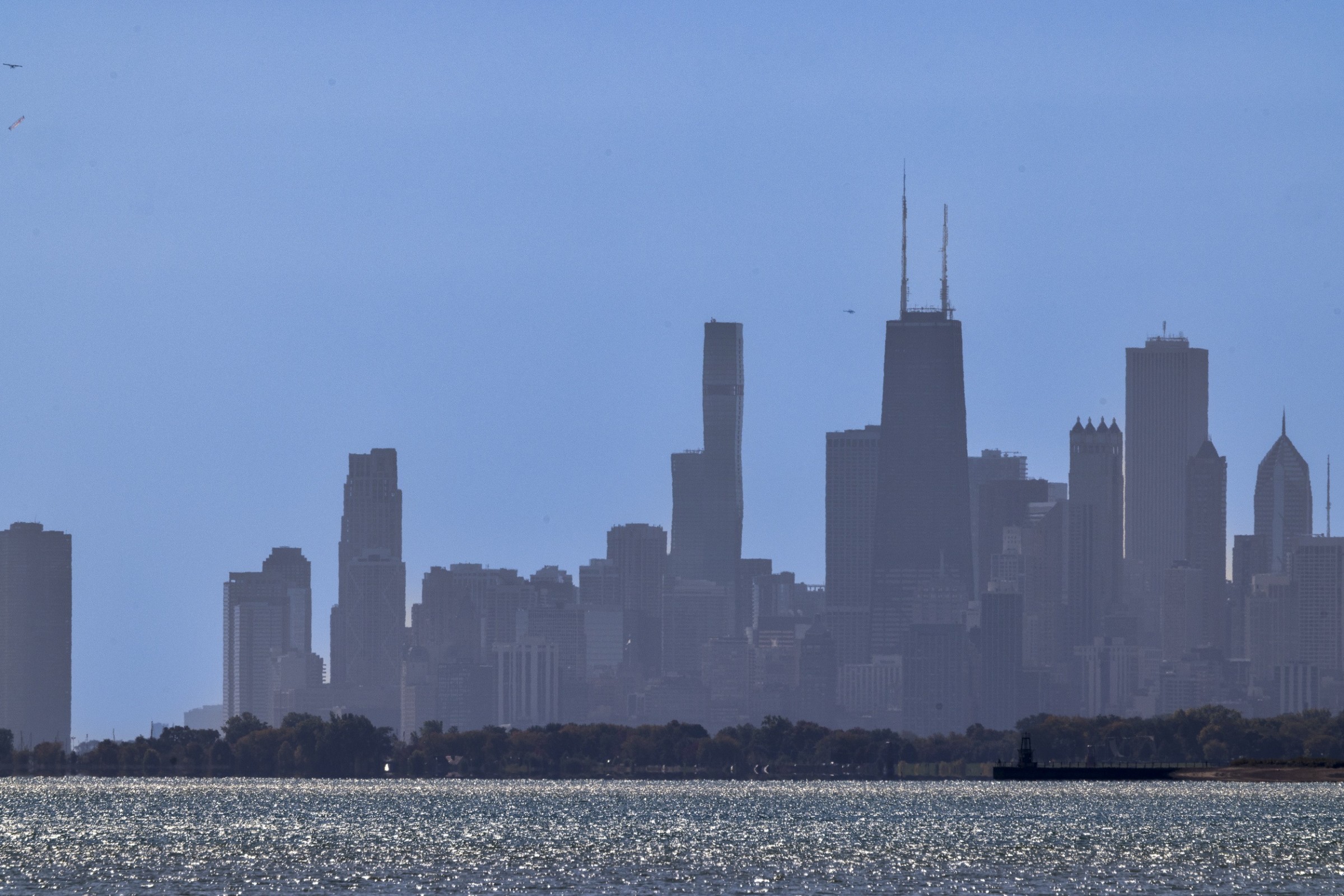America’s groundwater is now running dry where water is abundant.

Lights illuminate the street grid extending from Chicago. The city’s southwestern suburbs mined their groundwater and now need an alternate source. A group of six communities will soon receive Lake Michigan water from Chicago via pipeline. Photo © J. Carl Ganter/Circle of Blue
By Brett Walton, Circle of Blue – September 6, 2023
A city straddling the Des Plaines River that is less than 30 miles from one of the world’s largest freshwater lakes is an unexpected setting for a water shortage.
But that’s the situation in Joliet, the Illinois city on the verge of exhausting its groundwater supply.
For a century Joliet and its Will County neighbors mined their sandstone aquifer. In less than a decade the easy water will be gone for these communities in Chicago’s southwest suburbs. They can’t drill their way out; deeper layers of the aquifer are too salty and shallower units are vulnerable to contamination from road salts.
Illinois’s third largest city and five neighboring communities instead are banding together to secure an alternate source of supply. Their plan: tap Lake Michigan.
Unlike drilling another well, the plan incorporates horizontal infrastructure. The Will County communities will buy treated water from Chicago, which uses Lake Michigan as a source, and have it delivered via 65 miles of pipeline. Now in the design phase, the $1.4 billion project – the largest public works investment in Joliet’s history – is expected to break ground next year and be completed by 2030.
“Water is just taken for granted here,” Allison Swisher, Joliet’s director of public utilities, told Circle of Blue. “And so the thought that we might be running out of water is a difficult concept to understand when it seems like we have water all around us.”
The project is a reminder that even in rainy places that seem most water-secure – the shores of the Great Lakes, the Mississippi River basin – a reliable supply is not always assured. Typically associated with the drylands of Arizona or California, groundwater depletion is a national and regional emergency with implications for food production, housing, and economic development. The over-extraction of easily accessible groundwater is prompting local and state governments in Illinois and elsewhere to reckon with water limits – and consider new policies around water recycling, leak detection, and collaboration that would usher in a new age of resource stewardship.
Townships in Ottawa County, a high-growth area in west Michigan that abuts Lake Michigan, temporarily froze new housing starts in recent years when wells went dry. The county is investigating alternate supply options. Allendale Township, at the county’s center, is requiring new developments to connect to public utilities that use surface water. In an effort to oversee and manage groundwater depletion statewide, Michigan in 2008 began requiring farmers to register any new well capable of pumping at least 100,000 gallons a day and formed a team of state regulators to issue or deny new registrations.
In Minnesota and Wisconsin, high-capacity irrigation wells have depleted shallow sand aquifers in those states, which are also coping with nitrate contamination of groundwater in farm counties with large manure-producing feedlots and expansive corn production, the most heavily fertilized crop.
In Joliet, Swisher led the campaign for a new water source. Starting in 2018, the city of 150,000 people evaluated more than a dozen supply options. The Illinois and Kankakee rivers were found not to be suitable. A Lake Michigan intake across the state line, in Indiana, did not make the cut.
In the end, sourcing Lake Michigan water from Chicago emerged as the top option. To share the costs, Joliet brought in partners. It formed the Grand Prairie Water Commission along with the communities of Crest Hill, Channahon, Minooka, Shorewood, and Romeoville.
The project financing strategy is a mix of state and federal loans and bond issues. Each community will pay a share of the construction cost, divided according to its projected demand. In addition, commission members will pay Chicago for the water they use – about $30 million annually.
Communities in nearby Kane and Kendall counties that also rely on the deep sandstone aquifer will face similar water supply questions in the coming years. As the Chicagoland region reckons with freshwater limits an alternate path is generating discussion.

Chicago will supply Joliet with drinking water from Lake Michigan. Photo © J. Carl Ganter/Circle of Blue
Clean the Water, Use It Again
Lake Michigan, the thinking goes, ought to be reserved for drinking water. For other uses – especially the area’s refineries and chemical processing facilities – wastewater should be cleaned up and reused.
There’s a reason for this. A U.S. Supreme Court decree in 1967 capped Illinois’s Lake Michigan withdrawals. Joliet and its neighbors, because they are located outside the basin, will not return their wastewater to the Great Lakes system.
What would a regional wastewater recycling system look like? Researchers at the University of Illinois Chicago modeled one such option: a dual pipeline system for Joliet that delivers recycled water alongside fresh drinking water. The water would be sourced from the Metropolitan Water Reclamation District of Greater Chicago, the regional wastewater utility. Such dual systems are in use in Texas cities and shown to be effective.
“The truth of the matter is, with the shifting water geography, regions of relative abundance also have to get into reuse and conservation and new technologies,” Rachel Havrelock, the report’s co-author and director of The Freshwater Lab, told Circle of Blue. “We can’t just build the infrastructure as places are in the midst of a crisis. Anticipating it and building in advance to stave off massive crisis is equally important.”
The idea, however, may have come too late to be implemented alongside the Grand Prairie Water Commission pipeline. The University of Illinois at Chicago researchers did not discuss the concept with Joliet before publication, though the parties have had follow-up conversations to correct information in the report about Joliet’s water use and the availability of wastewater effluent from the city.
The Metropolitan Water Reclamation District of Greater Chicago commissioned the recycled water study. If the policy, engineering, and financial questions can be resolved, MWRD’s leadership is open to the idea that recycled water can ease future pressures on Lake Michigan.
Marcelino Garcia is an MWRD commissioner and the chair of the finance committee. Garcia told Circle of Blue that expanding recycled water use and extending pipelines to supply suburban communities with recycled water is “worthwhile” but not imminent. “There still needs to be many more conversations,” he said.
Those conversations are not limited to Chicago and its suburbs. State lawmakers must also act. The Illinois legal code currently does not allow wastewater recycling.
Changing that code is a goal of the Illinois Environmental Council. The council drafted a bill this year that would allow water to be reused.
House Bill 3046 advanced out of the Illinois House of Representatives but stalled in the Senate. Jennifer Walling, the council’s executive director, told Circle of Blue that she expects the bill to pass next year once some minor objections are cleared. “I do think it will have a future,” she said.
Patch the Leaks
Water recycling is not the only tool for a more sustainable regional water supply, said Nora Beck, a water planner at the Chicago Metropolitan Agency for Planning. Her group is working with communities to patch leaky pipes.
Illinois requires communities that draw from Lake Michigan to have less than 10 percent “non-revenue” water. By and large, this is water that leaks from municipal distribution pipes. In practice, the 10-percent standard is frequently violated. The Illinois Department of Natural Resources says that 43 percent of Lake Michigan permittees are not in compliance.
If Joliet were taking Lake Michigan water today, it would be among the offenders. Swisher said that the city’s non-revenue water is about 30 percent of its supply. So that it is not out of compliance when the pipeline comes online, Joliet is planning a $600 million program to replace water mains installed before 1970.
The investments, studies, and partnerships all point to a heightened awareness of the region’s water vulnerabilities and potential solutions. Researchers, advocates, and regional leaders say the next steps should come from Springfield.
“I think the state needs to be at the forefront, and try to come up with a water reuse plan,” Garcia said. “I think a lot of the water that’s being cleaned should be reused for either irrigation, or industrial uses, rather than using clean Lake Michigan water.” Such advances, he said, are overdue.
“If other parts of the world and the country have done it, we should,” Garcia added. “Just because we have Lake Michigan in our backyard doesn’t mean that we should use that water for everything.”
Brett writes about agriculture, energy, infrastructure, and the politics and economics of water in the United States. He also writes the Federal Water Tap, Circle of Blue’s weekly digest of U.S. government water news. He is the winner of two Society of Environmental Journalists reporting awards, one of the top honors in American environmental journalism: first place for explanatory reporting for a series on septic system pollution in the United States(2016) and third place for beat reporting in a small market (2014). He received the Sierra Club’s Distinguished Service Award in 2018. Brett lives in Seattle, where he hikes the mountains and bakes pies. Contact Brett Walton





